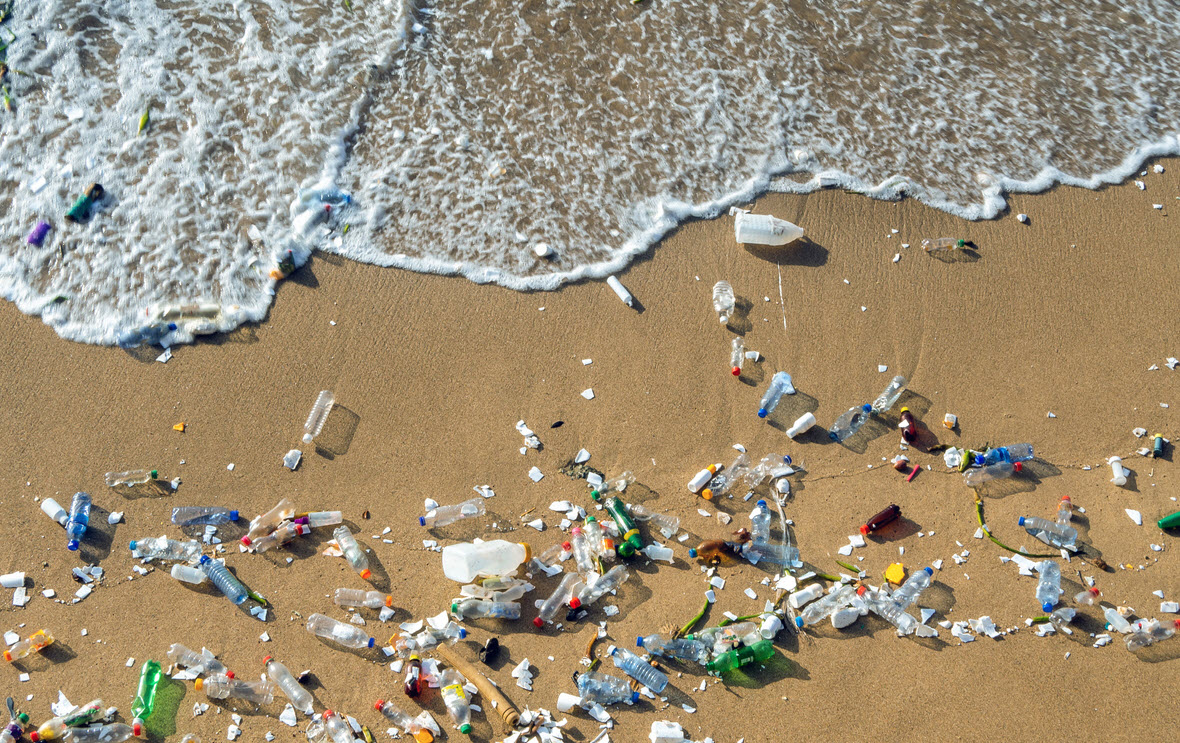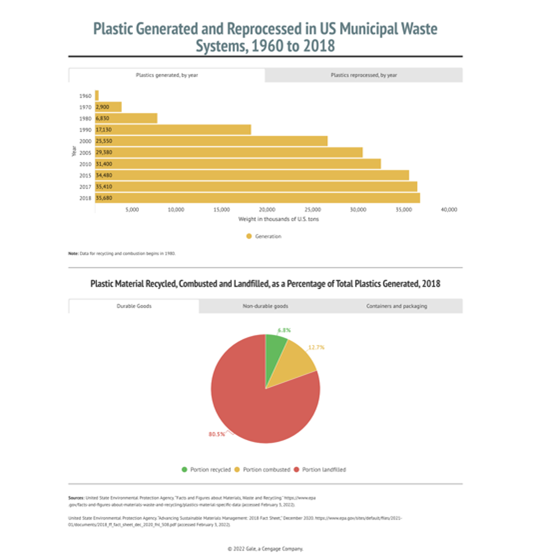| By Gale Staff |
We’ve gotten ourselves into a mess. Literally. The world’s oceans and sea life are in trouble—which means we are too. But has it always been this way? And is there something we can do to stop plastic pollution?
To honor this year’s World Environment Day (June 5) and World Oceans Day (June 8), learn more about the ecological challenges and history of plastic waste in Gale In Context: Opposing Viewpoints. These insights will help you understand how the collective efforts of changing day-to-day habits could protect our planet for generations to come. Share this content with students or patrons this month. This overview article includes two Lexile levels (4 and 5) for learners at different reading levels.
The Plastic Epidemic
Companies and politicians are finally taking cues from environmental activists and scientists when it comes to limiting the consumption of plastics and single-use items. But what’s slower to change than these policies are the expectations of two generations raised on throwaway culture. Since polyethylene, the most commonly used plastic, became available to the general population, we’ve made it an essential part of our daily lives. From single-use straws in our morning iced coffee to bottled drinks, grocery bags, food packaging, and takeout boxes, we have become huge consumers of plastic products without knowing it. And what’s more, we’ve become addicted. When everything is wrapped in plastic and we live on the go, it’s hard to stop.
Our love of plastic began in the 1950s and quickly accelerated when the disposable plastic grocery bag was invented in Sweden (see timeline below). Soon after, leading companies like Kroger and Safeway introduced the bags into their stores—and we never looked back. Disposable became the word of the future. Bringing a reusable bag to the grocery store or buying heavy, more expensive glass bottles became an inconvenience.
Unfortunately, plastic takes a long time to decompose—even under optimal conditions. The result? Slow decomposition and low recycling rates have left billions of tons of plastic for combustion, landfills, and improper disposal, with much of it ending up in oceans and waterways. One of the most infamous assemblages of marine litter is the Great Pacific Garbage Patch. Covering roughly the size of Mongolia, this ocean patch is a behemoth made up of microplastics (one-fifth of an inch in length) that have come together over time.
The Environmental Protection Agency (EPA) reports that containers and packaging make up more than 40 percent of plastic waste generated in the United States, accounting for more than 14 million tons in 2018. These numbers grow by the year, with estimates of plastic waste often doubling or tripling as the world population grows along with our dependency on plastic materials.
See the graphs below for a comprehensive view of how much plastic is generated and reprocessed each year.
What Can We Do?
Some U.S. states have started by issuing statewide bans of single-use plastics, while others allow retailers to distribute bags with a small levy or tax. Critics of these restrictions say that this is unfair to low-income families and small businesses that are taking on an economic burden best left for larger companies that contribute more waste than individual people.
For now, reducing waste is key. Many restaurants and bars have begun using more ecologically friendly compostable materials and only provide straws to people who ask for them. Larger corporations like Coca-Cola and McDonald’s have made ambitious pledges to make their operations more sustainable.
On an individual level, it’s up to each of us to monitor our use of single-use plastics. Observing our own habits is a huge part of reducing plastic waste and helping others understand where they can make small changes:
- If you have a collection of insulated mugs, keep one in your car so it’s on hand when you swing through your local coffee shop.
- If you have a vehicle, keep at least three reusable bags in your trunk so they’re at the ready when you’re running errands or grocery shopping.
- Get used to saying, “I don’t need a bag” if you’re picking up one or two items that can be carried by hand or in a backpack.
- Planning to take a trip? Bring a reusable water bottle for yourself and anyone you’re traveling with. You’ll not only reduce plastic waste, but you’ll also save money over time.
While there’s a lot that can be done by each of us individually, our collective efforts will be what matters in coming years. It’s estimated that by 2040, more than 36 million tons of plastic will enter the Earth’s oceans each year. And by 2050, the amount of plastic in the ocean will outweigh fish. The rate of plastic waste won’t come to a screeching halt with small efforts. Changes in policy and support for companies and leaders that are making significant changes is a good first step.
Want to learn more? Listen to audio from Team Seas, a group of YouTube influencers working to stem the flow of trash. You’ll learn more about Team Seas and the work they’re doing.
A Timeline
- 1950s – Polyethylene, the most commonly used type of plastic, became available for commercial use in the United States.
- 1965 – The Swedish packaging company Celloplast developed and patented the first disposable plastic bag, sometimes referred to as the T-shirt plastic bag because its shape resembles a sleeveless T-shirt.
- 1980s – Several companies began manufacturing these single-use plastic bags, and grocery stores, including Kroger and Safeway, began offering them to customers in 1982.
- 1985 – At least three quarters of U.S. leading grocery stores offered plastic bags to customers.
- 2007 – The city of San Francisco, California, enacted a ban on single-use plastic bags in grocery stores and pharmacies.
- 2015 – Hawaii and California banned single-use plastic bags in grocery stores.
- 2018 – The EPA determined that U.S. consumers generated 4.2 million tons of waste from plastic bags, sacks, and wraps. This amounts to about 12 percent of all plastic waste.
- 2019 – California became the first state to prohibit dine-in restaurants from giving plastic straws to customers unless they are requested, and many other state legislatures have similar laws pending or under consideration.
- 2020 – Efforts to reduce waste from single-use plastics were severely disrupted by the COVID-19 pandemic. Demand for single-use items, particularly gloves and other forms of personal protective equipment (PPE), rose significantly across the world. Similarly, lockdown orders led to more people using single-use packaging when ordering delivery and takeout.
- 2022 – Colorado, Connecticut, Delaware, Maine, New York, Oregon, Vermont, and Washington have passed legislation banning plastic bags statewide.
- 2040 – The Pew Charitable Trusts determines that in less than 20 years, over 36 million tons of plastic will enter the oceans each year.
- 2050 – The World Economic Forum predicts that the amount of plastic waste in the ocean will outweigh fish.


